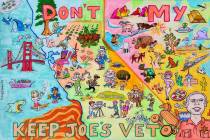Death Valley revealed in updated book about mystical desert place
Nevada is a land of mind-bending vistas and harsh hyperbole.
It’s a desert place with the largest manmade lake in the country. Known for its long, flat expanses, it is home to more than 200 mountain ranges.
Although we all know how hot it gets in Laughlin and Las Vegas, the Ely area is perennially one of the coldest spots in the nation.
And when it comes to geographic overstatement, Nevada’s front-row view of the amazing Death Valley cannot be beat. During my regular trips across the state, I often find myself dropping into Stovepipe Wells and over to Panamint Springs, or simply stopping by Rhyolite outside Beatty.
The Death Valley National Monument holds an almost mystical fascination not only for desert dwellers and people from around the world. One of the remarkable experiences to be had in Nevada Smith country is to find yourself in Death Valley Junction, Shoshone or Beatty listening to visitors speaking French, German, or Japanese.
Death Valley’s history is almost as mysterious as the place itself. It held a near-mythical presence in the hearts and minds of pioneers, who were tempted to use it as a shortcut to the gold fields of California. Native Americans have been a presence in the area for centuries. And in recent generations environmentalists have grown to champion it as a place worth fighting to preserve.
For those of us who are drawn to Death Valley, the University of Nevada Press has just published “Death Valley National Park: a History” by the late Hal Rothman and Char Miller. At 185 pages, it’s a compact but well-researched story first written by noted UNLV history professor Rothman and recently updated by Pomona College environmental professor Miller.
As an aside, it’s so good to see Rothman’s name in print again. He was a friend of Nevada and such a dynamic guy. The prolific writer and speaker was also a remarkable family man who embraced his profession at UNLV with great gusto. He worked until the last cruel ravages of Lou Gehrig’s disease took him in 2007 at age 48.
The text includes chapters on the natural history of the region and the story of how Death Valley came to be appreciated as a national park. There’s also an intriguing chapter on the interaction of Native Americans with the area.
The authors economically cover a lot of ground, and that’s a good thing. Death Valley National Park stretches more than 3.3 million acres. As Miller writes in his introduction, its “staggering dimension and arid beauty epitomize the concept of desert preservation. Though not the first national park in a desert, it is the most quintessential, with a history that is exceptionally diverse in its geological record, human activity, and cultural and natural resources.”
The book contains its share of insider politics and policy questions associated with the creation, growth and preservation of all national parks. Some of that is sure to be lost on the casual reader, but, as the authors note, Death Valley offers lessons for the visitor, scientist and federal bureaucrat alike.
With our national parks facing cutbacks in funding and environmental stresses at every turn, Death Valley faces a kind of tough love within the parks system. Its forboding terrain and summer heat aren’t as easy to appreciate for the casual visitor as a towering redwood forest or mile-deep Grand Canyon. But the times may be changing.
“In an era of climate change, the nation’s most arid park will be in a good position to help other entities anticipating less precipitation respond appropriately,” they write. “In an era of cost-cutting, Death Valley, which has had to address fiscal difficulties and staffing problems from its creation, will be in a good position to advise other parks on difficult budgetary choices.”
Death Valley needs all the friends it can get, and Rothman and Miller are good ones.
It’s enough to make me want to gas up the Subaru and make a trip to Panamint Springs. I’ll add their book to my shovel and spare tire because it’s also a useful tool.
“Death Valley National Park” is destined to become dog-eared and re-read, the fine dust of the mystical desert place itself sprinkling its pages.
John L. Smith writes for the Las Vegas Review-Journal. E-mail him at jsmith@reviewjournal.com or call (702) 383-0295.
















